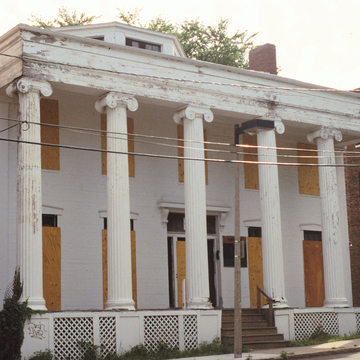Beginning in the late 1820s, Roxbury began to attract Boston's well-off businessmen and professionals who built country homes close to the city, following a grander pattern of country estates begun here in the mid-eighteenth century. Important examples of surviving houses are found on Highland Street, which branches off from John Eliot Square (RX11). Formerly on Highland but moved to a side street is the Edward Everett Hale House (NR/NRD) at 12 Morley Street. Erected by Benjamin Kent in 1841, the house was later the home of the famous writer, who lived here from 1869 until his death in 1909. An appropriate home for a classically educated author, this outstanding Greek Revival residence incorporates Ionic columns supporting a low-pitched pediment, flush board siding, and shouldered architrave trim for the windows.
Farther up Highland Street at Kittredge Square stands another Greek Revival house, the Kittredge House (12 Linwood Street, NR/NRD), with an Ionic portico, built in 1836. In roughly 1898, it was also turned to face a smaller side-street lot in order to accommodate higher density development, unfortunately losing its symmetrical flanking wings.
Probably the most important nineteenth-century resident of Roxbury, the great abolitionist William Lloyd Garrison lived at 125 Highland Street (NHL/NR/NRD) from 1864 to his death in 1879 (his only residence still standing). Now part of St. Margaret's Convent, the original portions of the house are visible from the hill overlooking Highland Street. Built in about 1854 for Joseph Hunnewell, the house boasts Italianate decorative features, such as paired brackets and a verandah supported on sets of paired columns, employed to embellish a traditional gable roof house. An unpretentious suburban dwelling, it suited the final years of a man whose great crusade against slavery had reached fruition.


